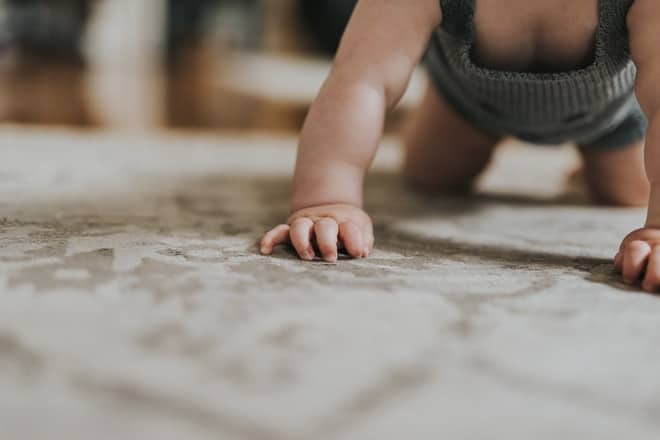Your baby may already be getting ready to crawl the moment he starts to push up on his knees and hands. Baby crawling, also called creeping, is one of the important motor milestones that establishes the foundation for higher-level motor skills such as running, climbing, walking, playground skills, and ball skills.

Most kids start crawling between the age of 7 and 9 months. Typical crawling develops visual skills, builds strength, coordinates both sides of the body, and facilitates cognitive development. Due to all its benefits, it is only ideal for kids to learn to crawl on their knees and hands. But your baby might demonstrate another form of floor mobility or crawling.
One condition that raises concerns among parents is asymmetrical crawling. If you notice this in your baby, learning how to fix asymmetrical crawling should be one of your top priorities.
What is Asymmetrical Crawling?
There are babies who learn to crawl with one foot and one knee. It is an asymmetrical pattern that parents want to prevent as much as possible. This may be due to an underlying asymmetry in the hips, muscles, or in the baby’s body awareness.
This type of crawling pattern will make your baby use just one side of the body more than the other side. This can also affect the vision, strength, and coordination of the two sides of the body.
Characteristics of Asymmetrical Crawling
- The baby uses one knee rather than two knees and one foot.
- The baby prefers lifting one hand over the other when trying to reach for toys.
- The baby’s pelvis shifts to one side while the spine curves to one side.
Impact of Asymmetrical Crawling on Development
- The baby is unaware of his true midline that affects their ability to use both sides of the body together and their visual orientation to the midline.
- As a result of the difference in the positions of the hips, the hip girdle, as well as the surrounding musculature, develop in a different way from one side to another.
- Future skills like learning how to stand may develop asymmetrically as the baby prefers to use one side of the body to shift weight over or push to stand.
- Spine always curves to one side which may result in scoliosis.
Is Asymmetrical Crawling Normal?
If you are wondering if asymmetrical crawling is a bad thing, it is important to remember that it often indicates that there are coordination problems, low muscle tone, or delays in development. What matters here is that you don’t freak out and assume that there is something wrong with your baby.
If you suspect that your child doesn’t crawl properly for whatever reason, the best thing you can do is to take a video of the movement that you can show to the pediatrician so you can get a proper diagnosis.
Many doctors are not worried when they see a baby crawling asymmetrically provided that the muscle tone and strength start to develop on both sides of the body.
When you note asymmetry as your child shifts from sitting to onto his belly or he doesn’t equally engage both sides of the body when they hold things in their hands, it is another area you should be concerned with.
Does Asymmetrical Crawling Indicate Autism?
The good news is that asymmetrical crawling is not an automatic indication that your baby has autism. There are babies who initially pull to just one side over the other. There are also others who drag one leg or just rest one foot down below them so they can propel themselves.
While there are studies that show autistic children making asymmetrical movements when crawling, it doesn’t mean your baby is already autistic.
Tips to Fix Asymmetrical Crawling
Panicking will never get you anywhere if you notice your baby crawling asymmetrically. Here are a few tips you can try to fix your baby’s asymmetrical crawling:
Crawling Over Obstacles or Pillows
Every time your baby crawls over obstacles or pillows, they find it more difficult to lift up that one foot and crawl asymmetrically. Letting them crawl over surfaces like these is one of the best ways to address asymmetrical crawling.
Facilitation
Another effective way of fixing asymmetrical crawling is to hold the ankle of your baby very gently while he crawls. This will restrict your child from using just one foot that is leading to an asymmetrical crawl. This will instead facilitate your baby to use his knee to crawl.
Also, if your baby crawls asymmetrically, you can try to gently swoop back that one leg to a knee crawling position. it is a technique that also corrects asymmetrical crawling.
However, you have to keep in mind that a weak core can be one of the underlying causes of your baby’s asymmetrical crawling. This means that when you apply these techniques, your baby may faceplant because of their weak core.
Also, while it is important to apply these two techniques regularly, make sure that you don’t overdo them. For instance, you can try letting your baby crawl your baby asymmetrically sometimes and use the techniques at times to fix their crawling. You should also be very careful and gentle when you apply these techniques.
Kneeling
One effective way to strengthen the core and hips of your baby is supported kneeling or kneeling at a support surface. This can also help to fix asymmetrical crawling. You can facilitate your baby to kneel while playing to address the issue. You can also let him push some obstacles forward such as a box while he is on his knees to help correct his crawling.
Physioball
A physioball can also come in handy when fixing your little one’s crawling pattern. Weight shifting and bouncing from one side to another or forward back are all helpful exercises to activate muscles and strengthen the core.
Side Sitting
Side sitting can help your baby strengthen his trunk and hip and work on balance. If your baby has any weaknesses or asymmetries on one side, this form of sitting can help fix asymmetries and get them stronger.
Sit Up
Another effective form of exercise on to fix a child’s asymmetrical crawling is sit-up.
Does Crawling Hurt Baby’s Knees?
There’s no question that crawling is an important milestone in a baby’s development, but does it hurt their knees? The answer is a little complicated. Crawling does put some stress on young joints, but it’s a good kind of stress that helps them grow stronger. As long as your baby is comfortable and has plenty of pillows and blankets to crawl on, let them go at it!
How Long Should Baby Crawl?
When it comes to baby crawling, there seems to be a lot of conflicting information out there. How long should baby crawl? What’s the average amount of time baby spends crawling? How can parents help their baby crawl sooner?
There is no definitive answer to this question as every baby is different. However, the general consensus is that babies should crawl around for at least an hour each day. This helps them develop their muscles and coordination. In addition, crawling helps babies learn about their surroundings and how to interact with them.













